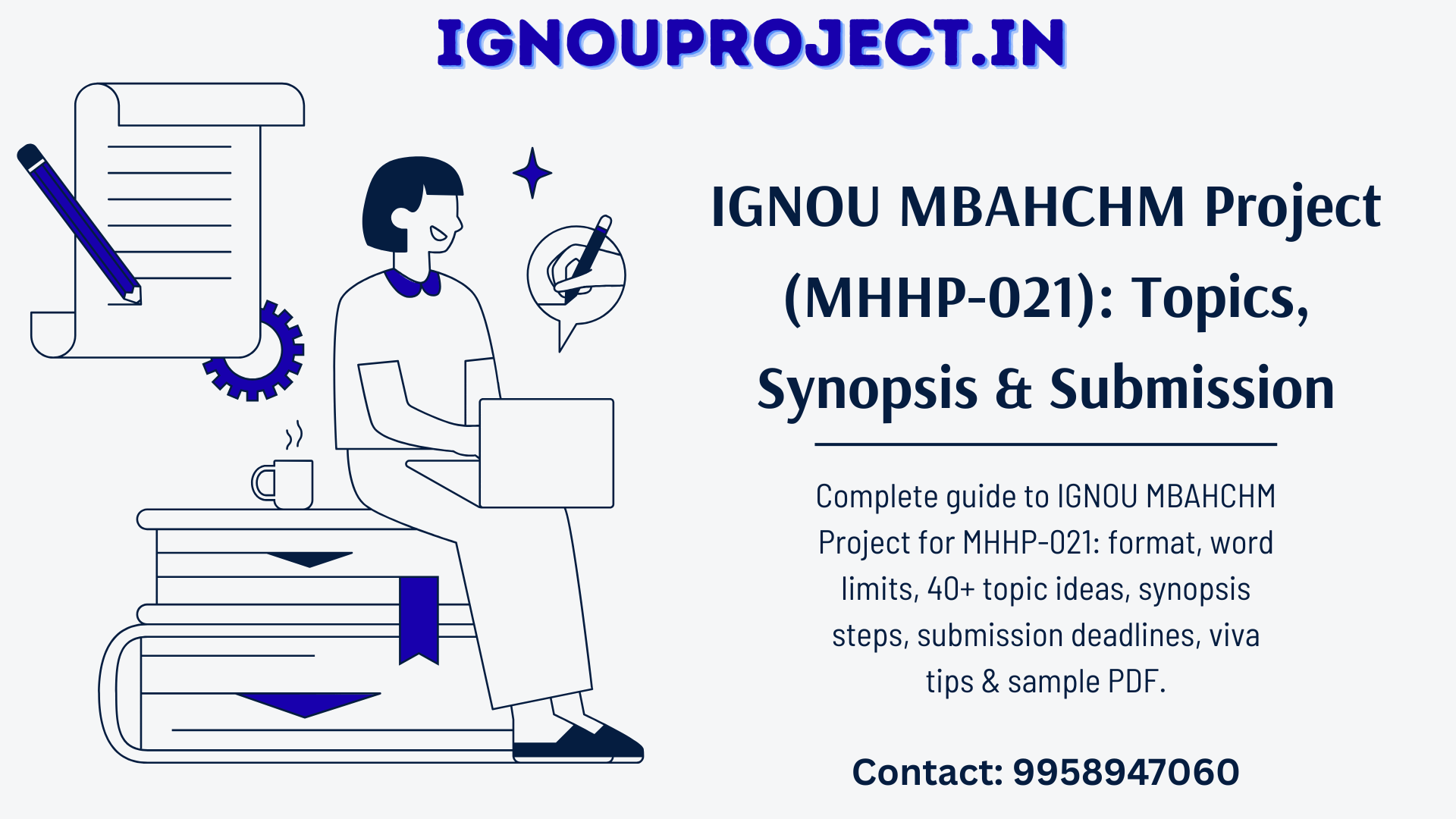The IGNOU MBAHCHM Project for MHHP-021 offered by the Indira Gandhi National Open University (IGNOU) equips professionals with managerial skills tailored to healthcare settings. A pivotal part of this programme is MHHP‑021, a six‑credit project course that requires students to investigate a real‑world healthcare problem and apply research methodologies to propose practical solutions.
Undertaking the MBAHCHM project not only fulfils academic requirements but also helps learners build research, analytical and presentation capabilities crucial for hospital administration and health‑policy roles. This guide consolidates official regulations, recommended formats and practical tips to assist you from topic selection through viva‑voce.
Key Highlights & Quick Summary
- The MHHP‑021 project is a mandatory research component in IGNOU’s MBAHCHM programme. It carries six credits, roughly equating to 180 hours of student effort.
- Unlike regular courses that use assignments and term‑end exams for evaluation, the project is assessed solely on the submitted report.
- Reports should be bound in A4 format and typically span 50–60 double‑spaced pages (around 18,000 words).
- The project must include a title page, certificate and declaration, followed by chapters covering the introduction, literature review, methodology, data analysis and recommendations.
- Students can submit the report any time; those submitted between 1 December and 31 May are assessed with the June term‑end exam, while those submitted between 1 June and 30 November are assessed with the December exam.
- A viva‑voce may be conducted if the evaluator deems it necessary.
Table of contents
What Is the MHHP‑021 in IGNOU MBAHCHM Project?
Credits, Objectives & Evaluation Weightage
MHHP‑021 is the project course in the MBAHCHM curriculum. The programme guide lists it among the 26 courses and assigns six credits, signifying the amount of academic workload expected. The project’s objective is to develop the student’s ability to apply multi‑disciplinary concepts, tools and techniques to analyse healthcare organisations and formulate recommendations. Unlike other courses, MHHP‑021 does not require a separate assignment or term‑end exam; the entire evaluation is based on the project report submitted to the regional centre. Evaluators may request a viva‑voce to verify understanding and authenticity.
Eligibility & Pre‑requisites
You become eligible for MHHP‑021 after completing the second semester and registering for the third semester. It is advisable to finish foundational courses such as hospital operations, healthcare quality management and research methodology before starting the project. Students must identify a guide (supervisor) with relevant qualifications—typically a faculty member or experienced healthcare professional—and have the proposed topic approved through a synopsis before proceeding. Working professionals can choose topics from their own organisations, provided there is no conflict of interest and ethical clearance is obtained.
IGNOU MBAHCHM Project Format (Chapter‑Wise)
IGNOU’s general project guidelines prescribe a structure of around 50–60 double‑spaced typed pages (about 18,000 words). While MHHP‑021 may allow flexibility, adhering to this structure ensures a comprehensive and reader‑friendly report.
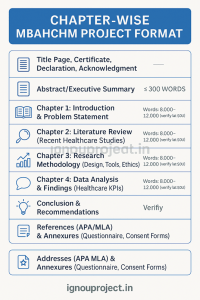
Figure: Chapter-Wise MBAHCHM Project Format
Title Page, Certificate, Declaration, Acknowledgement
- Title Page: Should mention the project title, student’s name, enrolment number, programme (MBAHCHM), course code (MHHP‑021), study centre, and submission month and year.
- Certificate of Originality: Signed by both the student and the project guide, certifying that the work is original and not submitted elsewhere.
- Declaration: A statement by the student affirming authenticity and acknowledging sources. Include the guide’s signature and date.
- Acknowledgement: Optional but recommended to thank mentors, institutions and participants.
Abstract/Executive Summary
Write a concise summary (250–300 words) outlining the problem statement, objectives, methodology, key findings and recommendations. Although placed before Chapter 1, it should be written last so that it accurately reflects the entire report. Keep it self‑contained; readers should grasp the project’s essence without referring to the main text.
Chapter 1: Introduction & Problem Statement
Introduce the healthcare organisation or system you are studying. Describe the context, such as hospital size, location, services and strategic priorities. Define the problem statement that motivates your research—for instance, long patient waits times, low patient satisfaction or inadequate waste management. Clearly specify the research objectives and scope: whether you aim to evaluate quality indicators, examine operational efficiency, or assess digital health adoption. Conclude with research questions or hypotheses and clarify any assumptions.
Chapter 2: Literature Review (Recent Healthcare Studies)
Review recent literature relevant to your topic, with emphasis on Indian healthcare settings. Summarise studies on hospital operations, patient satisfaction, quality accreditation (e.g., NABH), telemedicine adoption or biomedical waste management. Use peer‑reviewed journals, government reports and industry surveys; summarise key theories and frameworks guiding your research. Identify gaps in existing knowledge that your project seeks to address. Maintain critical analysis rather than merely describing previous studies.
Chapter 3: Research Methodology (Design, Tools, Ethics)
This chapter should detail research design (descriptive, exploratory or experimental), sampling strategy, data collection instruments and analysis techniques. Explain whether your study employs quantitative methods (surveys, audits) or qualitative methods (interviews, focus groups) or a mixed approach. Outline the population, sample size, sampling technique (random, stratified or convenience) and inclusion/exclusion criteria. Describe instruments such as patient satisfaction questionnaires, observation checklists or telemedicine adoption scales. Include procedures for pre‑testing the questionnaire and ensuring reliability. Discuss ethical considerations: informed consent, confidentiality, anonymity, data storage and compliance with institutional review boards or similar ethical committees.
Chapter 4: Data Analysis & Findings (Healthcare KPIs)
Present the data systematically using tables, charts and graphs. Analyse key performance indicators (KPIs) relevant to healthcare—wait times, bed occupancy rates, infection rates, patient satisfaction scores or compliance with NABH standards. Use statistical methods appropriate to your data (descriptive statistics, chi‑square tests, correlation, regression). Where applicable, compare your findings against benchmarks or previous studies. Provide narrative explanations to interpret patterns and anomalies.
Chapter 5: Discussion, Implications & Limitations
Interpret the findings in light of your objectives and literature review. Discuss how the results address the research questions and what they imply for healthcare management practices. Identify practical recommendations—changes in process flow, training, adoption of technology, or policy interventions. Acknowledge limitations such as small sample size, response bias or limited generalisability. Suggest directions for future research, emphasising areas where knowledge gaps remain.
Conclusion & Recommendations
Summarise the entire MBAHCHM project, restating the problem, methodology and key findings. Provide actionable recommendations tailored to stakeholders, such as hospital administrators, policymakers or clinicians. Highlight the potential impact of implementing these recommendations on patient care, operational efficiency and overall healthcare quality. Conclude by reflecting on the learning outcomes and professional value derived from the project.
References (APA/MLA) & Annexures (Questionnaire, Consent Forms)
List all sources cited in the report using a consistent referencing style (APA or MLA). Include only those references actually used. Attach annexures containing the data collection instruments—questionnaires, interview guides, informed consent forms, ethical approval letters and raw data tables. Label each annexure clearly and refer to them in the relevant chapters.
IGNOU MBAHCHM Synopsis (Proposal) Writing for MHHP‑021—Step‑by‑Step
Writing a well‑structured MBAHCHM synopsis is crucial because your project proposal must be approved before you start your MHHP‑021 research. IGNOU’s general guidelines require a project proposal proforma signed by both the student and the guide. Below is a suggested structure.
Title, Rationale, Objectives, Hypotheses/Questions
- Title: Craft a concise, informative title that reflects the problem area, population and methodology. Example: “Assessing Patient Satisfaction in the Out‑patient Department of a Tertiary Hospital.”
- Rationale: Explain why the study is important—link to gaps in literature or organisational needs. For instance, high patient wait times may compromise quality of care.
- Objectives: List specific, measurable objectives (e.g., to evaluate patient satisfaction levels across service areas; to identify factors influencing satisfaction). Include research questions or hypotheses if using inferential statistics.
Methodology (Sampling, Tools, Ethics, Timeline)
Describe the study design (cross‑sectional survey, case study, intervention). Specify population, sampling technique, sample size calculation and inclusion criteria. Outline data collection tools: questionnaires, checklists, observation sheets or EHR extracts. Detail data analysis methods (descriptive statistics, thematic analysis). Explain ethical procedures: obtaining consent, anonymity, data storage and compliance with institutional review boards. Provide a tentative timeline of activities from approval to report submission.
Expected Outcomes & Deliverables
Predict the potential findings and their implications for hospital management. This might include insights into patient satisfaction drivers, recommendations to improve appointment scheduling or evidence supporting adoption of telemedicine. Mention deliverables such as datasets, analysis reports, presentations or policy briefs.
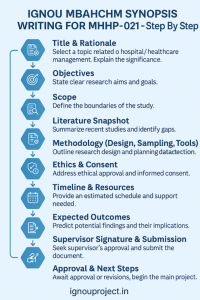
Figure: IGNOU MBAHCHM Synopsis Writing for MHHP 021—Step by Step
Common Reasons for Rejection & How to Avoid Them
MBAHCHM Project proposals are often rejected due to vague objectives, unrealistic scope, poor methodology or lack of alignment with healthcare management. To avoid rejection:
- Ensure your topic is original and relevant to healthcare. Avoid choosing widely studied topics without a new perspective.
- Provide clear objectives and research questions. Avoid generic statements.
- Select a feasible methodology given your time, resources and sample access.
- Obtain necessary ethical approvals and consent processes. Include a valid guide’s signature and bio‑data in the proforma.
- Proofread for grammar and clarity; incomplete or poorly written proposals are more likely to be returned.
- Learn how to write an IGNOU MBAHCHM Synopsis
40+ IGNOU MBAHCHM Project Topic Ideas (By Healthcare Segment)
Hospital Operations & Patient Flow
- Evaluating the effectiveness of lean management techniques in reducing patient wait times in the outpatient department.
- Analysis of bed occupancy rates and turnover times to optimise admission and discharge processes.
- Impact of online appointment scheduling on walk‑in patient flow and no‑show rates.
- Comparative study of emergency department triage systems and their effect on patient outcomes.
- Assessment of pharmacy inventory management using the ABC–VED analysis method.
- Time‑motion study of diagnostic services (laboratory and radiology) to identify bottlenecks.
- Impact of tele‑triage services on reducing unnecessary hospital visits.
- Process reengineering of operation theatre scheduling for improved utilisation.
Quality & NABH Compliance
- Measurement of compliance with National Accreditation Board for Hospitals (NABH) indicators across departments.
- Audit of infection control practices and their effect on hospital‑acquired infection rates.
- Evaluation of continuous quality improvement (CQI) initiatives in nursing care standards.
- Study on effectiveness of clinical audit programmes in reducing medication errors.
- Analysis of patient safety culture using validated instruments (e.g., HSOPS).
- Investigating the role of clinical governance in enhancing quality of care.
- Impact of root cause analysis training on incident reporting and learning.
- Assessment of blood transfusion practices against NABH requirements.
Digital Health & Telemedicine
- Exploring factors influencing telemedicine adoption among physicians in rural India.
- Evaluation of electronic health record (EHR) implementation on workflow efficiency.
- Assessing usability of mobile health apps for chronic disease management.
- Comparative study of teleconsultation versus in‑person consultation satisfaction levels.
- Barriers and facilitators to implementing hospital information systems in tertiary care centres.
- Impact of digital health literacy on telehealth utilisation among elderly patients.
- Study on the effectiveness of remote patient monitoring in reducing readmissions.
- Security and privacy challenges in cloud‑based health information systems.
Healthcare Marketing & Patient Experience
- Analysis of hospital marketing strategies and their influence on patient choice.
- Evaluating brand loyalty drivers among private hospital patients.
- Study on patient perception of transparency in healthcare billing.
- Assessment of social media campaigns in promoting public health awareness.
- Exploring the role of service design in enhancing patient experience at registration counters.
- Determinants of patient loyalty in multispecialty hospitals.
- Influence of hospital ambience and facility aesthetics on patient satisfaction.
- Impact of corporate social responsibility (CSR) initiatives on hospital reputation.
Public Health, Insurance & Policy
- Evaluation of awareness and utilisation of government health insurance schemes (e.g., Ayushman Bharat).
- Analysis of barriers to health insurance enrolment among informal sector workers.
- Effectiveness of community health worker programmes in maternal and child health.
- Study on implementation challenges of national health programmes at the district level.
- Impact of policy interventions on reducing out‑of‑pocket expenditure in healthcare.
- Assessment of health equity in access to tertiary care across urban and rural populations.
- Evaluating vaccine hesitancy and strategies to improve immunisation coverage.
- Analysis of public–private partnership models in rural healthcare delivery.
Biomedical Waste, Safety & Sustainability
- Assessment of biomedical waste management compliance with national guidelines.
- Comparative study of waste segregation practices in public versus private hospitals.
- Evaluation of environmental sustainability initiatives in hospital operations.
- Study on occupational hazards faced by hospital housekeeping staff.
- Analysis of energy efficiency measures and cost savings in hospitals.
- Effectiveness of staff training on safe handling of sharps and infectious waste.
- Barriers to adopting green building practices in healthcare facilities.
- Impact of hospital vaccination policies on staff safety and patient outcomes.
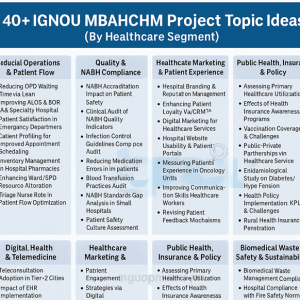
Figure: 40+ IGNOU MBAHCHM Project Topic Ideas (By Healthcare Segment)
Data Collection Tools for Healthcare Studies (MHHP-021)
Sample Questionnaire (OPD/IPD, Pharmacy, Billing)
Designing robust questionnaires is central to quantitative healthcare research. A well‑constructed patient satisfaction questionnaire should include domains such as appointment scheduling, waiting time, doctor–patient communication, nursing care, cleanliness, pharmacy services and billing transparency. Use Likert scales (e.g., 1 = Very Dissatisfied, 5 = Very Satisfied) and include demographic items (age, gender, visit type). Pre‑test the instrument with a small group to ensure clarity and reliability. For pharmacy studies, incorporate questions on drug availability, counselling and waiting times. For billing, ask about understanding of charges, transparency and payment convenience.
Observation & Interview Protocols
Observation checklists are useful for evaluating processes like hand‑hygiene compliance or patient flow. Develop a structured checklist based on standard guidelines (NABH or WHO) and train observers to ensure consistent data collection. Interview protocols should start with open‑ended questions to encourage participants (patients, clinicians, administrators) to share experiences. Follow up with probing questions while maintaining neutrality. Record interviews with consent and transcribe for qualitative analysis using coding frameworks.
Ethics, Consent & Data Privacy (HIPAA‑like Practices/Context)
Ethical compliance is paramount. Prior to data collection, secure approval from an institutional ethics committee or research review board. Prepare informed consent forms detailing the study’s purpose, procedures, risks, benefits, confidentiality measures and voluntary participation rights. For vulnerable populations, ensure additional safeguards. Protect data privacy by anonymising identifiers, storing data in encrypted files and limiting access. When using electronic data, comply with local regulations and international standards akin to HIPAA to safeguard personal health information. Communicate participants’ rights to withdraw at any time without penalty.
IGNOU MBAHCHM Project Submission Workflow & Deadlines (Jan vs July Cycle)
Binding, Cover Page, File Naming & Delivery
- Binding: The final report must be printed on A4 paper, double‑spaced and bound (hard or spiral binding). Handwritten reports are not accepted. Include the approved proposal, guide’s bio‑data and originality certificate at the beginning.
- Cover Page: Use the standard layout with the title, student and programme details. Place the IGNOU logo if required. Many students also include a certificate of originality signed by the guide.
- File Naming: When submitting digital copies (if allowed), follow naming conventions such as EnrolNo_Name_MHHP021.docx. For printed reports, label the spine with your enrolment number and project title.
- Delivery: Submit the report to your Regional Centre via speed post or in person. Do not send it directly to headquarters unless instructed. Obtain a receipt or acknowledgment for future reference.
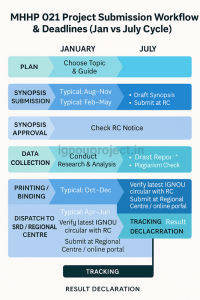
Figure: MHHP 021 Project Submission Workflow & Deadlines (Jan vs July Cycle)
Tracking, Resubmission & Result Checking
After submission, track the status through the IGNOU project portal or contact the regional centre. If the evaluator suggests modifications or rejects the report due to major deficiencies, you may need to resubmit. The results of projects submitted between 1 December and 31 May are declared along with the June term‑end exam; those submitted between 1 June and 30 November are declared with the December exam.
Students should monitor their grade cards; once marks are entered, they can collect the evaluated report from the regional centre. If called for a viva‑voce, prepare to answer questions about your methodology, findings and implications.
Viva‑Voce Preparation: Likely Questions & Tips
The viva‑voce, if conducted, assesses your understanding of the project and ensures authenticity. Prepare for the following types of questions:
- Rationale and significance: Why did you choose this topic? How does it contribute to healthcare management?
- Methodology: How did you determine the sample size? Why did you choose a particular research design or instrument?
- Data analysis: What statistical tests did you use? How did you ensure data validity and reliability?
- Findings: What were the key trends? How do they compare with existing literature or benchmarks?
- Recommendations: How feasible are your proposed solutions? What barriers might you face in implementing them?
- Limitations: What were the limitations of your study and how could future research address them?
Tips for success: review your report thoroughly, practise explaining complex concepts in simple terms, anticipate counter‑arguments and maintain a professional demeanour. Bring a copy of your report for reference, and be honest if you don’t recall a specific detail.
Downloadable Resources
While IGNOU does not provide a specific sample project for MHHP‑021, students can refer to generic project guidelines from the MMPP 001 course as a template.
- IGNOU MBAHCHM Project Guidelines / Handbook
- IGNOU MBAHCHM Project Synopsis Sample PDF
- MHHP 021 Project Sample PDF in MBAHCHM
- IGNOU MBAHCHM MHHP-021 Project Topic List
FAQs – IGNOU MBAHCHM Project for MHHP‑021
1. Is MHHP‑021 compulsory?
Yes. All MBAHCHM students must complete MHHP‑021 in the third semester.
2. How long should the MBAHCHM project report be?
The recommended length is 50–60 double‑spaced pages, roughly 18,000 words. Appendices and annexures are excluded from this count.
3. Do I need a guide for my IGNOU MBAHCHM Project work?
Yes. The proposal and final report must be supervised by a qualified guide and accompanied by the guide’s bio‑data and signature.
4. Can I choose any topic for MBAHCHM project?
Choose topics relevant to hospital and healthcare management. The university can reject proposals that are unrelated or lack feasibility.
5. Will there be a viva in MHHP 021 project?
Possibly. The evaluator may call you for a viva‑voce to verify authenticity and comprehension.
6. Can I submit the MBAHCHM project online?
Submission procedures vary by regional centre. Some centres accept digital copies along with the printed report. Always confirm with your regional coordinator.
7. What happens if my MBAHCHM proposal is rejected?
You must revise and resubmit the proposal based on feedback. Delayed approval can postpone your project work, so address reviewers’ comments promptly.
Conclusion
The MHHP‑021 project is a capstone experience in the IGNOU MBAHCHM programme, challenging students to integrate theoretical knowledge with practical research. By following the structured format—ranging from title page and abstract to data analysis and recommendations—you ensure a comprehensive and academically sound report. Adhering to submission protocols, meeting deadlines and preparing for a possible viva will facilitate smooth evaluation.
Ultimately, the IGNOU MBAHCHM project empowers future healthcare managers to tackle operational challenges, enhance quality and contribute to the evolving healthcare landscape.
👉 To learn more about MBAHCHM project writing, check out our blogs:
Need Help in IGNOU MBAHCHM Project (MHHP 021)?
Completing the IGNOU MBAHCHM project for MHHP‑021 is an opportunity to apply healthcare management concepts to real‑world problems. Begin early by selecting a meaningful topic, writing a clear synopsis and consulting your guide regularly. Follow the prescribed format meticulously, adhere to ethical norms and maintain originality. With careful planning and dedication, your project can contribute valuable insights to hospital administration and enhance your professional profile.
Get expert assistance, topic suggestions, and ready-to-submit project reports now!
👉 [Contact Us] | 🌐 Visit: ignouproject.in

